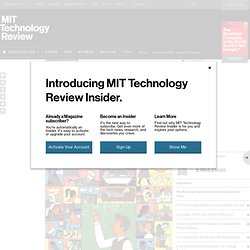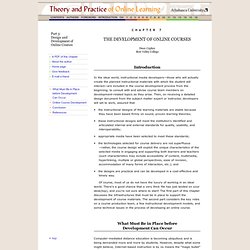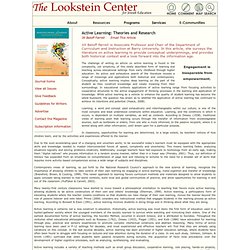

Teaching intelligence - This game is wide open. If Moocs are the future of learning, they’re still not without precedents or pitfalls, reports Tom Barfield Credit: KobalLonely learner not everyone wishes to study in isolation.

The social element may be a key component, but not all Moocs provide it Depending on who you believe, massive open online courses (Moocs) are variously the bright future of university education, its onrushing nemesis, or just about anything on the spectrum in between. The basic structure of a Mooc is simple: a company or institution sets up a website where prospective students can register and peruse a list of courses. Digital Education. If you were asked to name the most important innovation in transportation over the last 200 years, you might say the combustion engine, air travel, Henry Ford’s Model-T production line, or even the bicycle.

The list goes on. Now answer this one: what’s been the single biggest innovation in education? Don’t worry if you come up blank. You’re supposed to. The question is a gambit used by Anant Agarwal, the computer scientist named this year to head edX, a $60 million MIT-Harvard effort to stream a college education over the Web, free, to anyone who wants one. Agarwal believes that education is about to change dramatically. Online education isn’t new—in the United States more than 700,000 students now study in full-time “distance learning” programs.
These ideas affect markets so large that their value is difficult to quantify. In Christensen’s view, disruptive technologies find success initially in markets “where the alternative is nothing.” Digital instruction faces limits.
Learning Theories. Mazur Group Presentations. Chapter 7. Chapter 7 The Development of Online Courses Dean Caplan Bow Valley College In the ideal world, instructional media developers—those who will actually create the planned instructional materials with which the student will interact—are included in the course development process from the beginning, to consult with and advise course team members on development-related topics as they arise.

Then, on receiving a detailed design document from the subject matter expert or instructor, developers will set to work, assured that • the instructional designs of the learning materials are stable because they have been based firmly on sound, proven learning theories; • these instructional designs will meet the institution's identified and articulated internal and external standards for quality, usability, and interoperability; • appropriate media have been selected to meet these standards; • the designs are practical and can be developed in a cost-effective and timely way. top Definition of an Online Course 1.
Active Learning: Theories and Research. Contemporary views of learning, as put forth by the National Research Council’s approach to the new science of learning, recognize the importance of allowing children to take control of their own learning by engaging in active learning, meta-cognition and transfer of knowledge (Bransford, Brown, & Cocking, 1999).

This newer approach to learning favors curriculum methods and materials designed to allow students to apply concepts being learned to real-world contexts, build local and global communities of practice, and allow opportunities for learning in and out of the classroom (Huffaker & Calvert, 2003). Many twenty-first century classrooms have started to move toward a philosophical orientation to teaching that favors more active learning, allowing students to be active constructors of their own and others’ knowledge (Ellerman, 1999). Active learning is certainly not a new construct in education. Teaching strategies that promote active learning have five common elements. References. Inquiry-based Learning With and Without Facilitator Interactions.
Thushani Alwis Weerasinghe, Robert Ramberg and Kamalanath Priyantha Hewagamage VOL. 26, No. 2 This paper discusses findings of a study investigating how students, in four online courses, engaged in inquiry-based learning with and without support from a facilitator.

The investigation was conducted by analyzing discussions of the online courses using the community of inquiry model. How People Learn: Brain, Mind, Experience, and School: Expanded Edition. This popular trade book, originally released in hardcover in the Spring of 1999, has been newly expanded to show how the theories and insights from the original book can translate into actions and practice, now making a real connection between classroom activities and learning behavior.

This paperback edition includes far-reaching suggestions for research that could increase the impact that classroom teaching has on actual learning. Like the original hardcover edition, this book offers exciting new research about the mind and the brain that provides answers to a number of compelling questions. When do infants begin to learn?
Teaching and Learning. Introducing Generation C: Americans 18-34 Are the Most Connected. Born sometime between the launch of the VCR and the commercialization of the Internet, Americans 18-34 are redefining media consumption with their unique embrace of all things digital.

According to Nielsen and NM Incite's U.S. Digital Consumer Report, this group—dubbed “Generation C” by Nielsen—is taking their personal connection—with each other and content—to new levels, new devices and new experiences like no other age group. The latest Census reports that Americans 18-34 make up 23 percent of the U.S. population, yet they represent an outsized portion of consumers watching online video (27%), visiting social networking/blog sites (27%), owning tablets (33%) and using a smartphone (39%). Their ownership and use of connected devices makes them incredibly unique consumers, representing both a challenge and opportunity for marketers and content providers alike. Generation C is engaging in new ways and there are more touch points for marketers to reach them. [/caption]